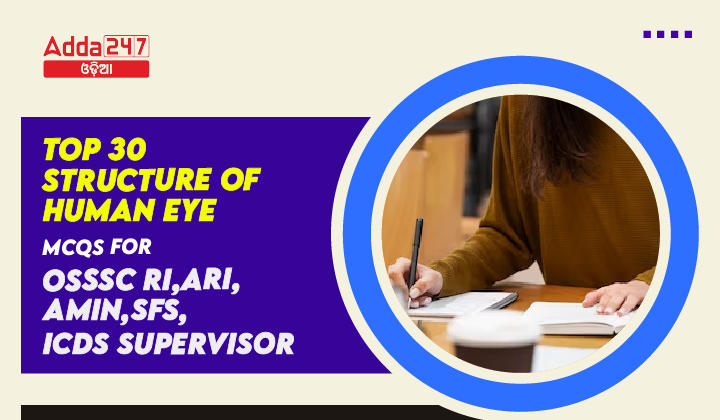Are you gearing up for competitive exams in the field of medicine, biology, or ophthalmology? Understanding the intricacies of the human eye is crucial for success in these exams. To assist you in your preparation, we’ve curated a list of the top 30 multiple-choice questions (MCQs) focusing on the structure of the human eye. Each question is accompanied by a detailed explanation of the correct answer to enhance your understanding. Let’s dive in!
Top 30 Structure Of Human Eye MCQS For OSSSC RI,ARI, Amin, SFS, ICDS Supervisor
- What is the outermost layer of the human eye called?
A) Retina
B) Sclera
C) Cornea
D) Iris
Correct Answer: B) Sclera
Explanation: The sclera is the tough, outermost layer of the eye, providing structural support and protection. - Which structure of the eye regulates the amount of light entering the eye?
A) Cornea
B) Lens
C) Retina
D) Iris
Correct Answer: D) Iris
Explanation: The iris controls the size of the pupil, thereby regulating the amount of light that enters the eye. - Which part of the eye contains photoreceptor cells responsible for vision?
A) Retina
B) Lens
C) Cornea
D) Sclera
Correct Answer: A) Retina
Explanation: The retina is the innermost layer of the eye that contains photoreceptor cells (rods and cones) responsible for vision. - What is the function of the lens in the eye?
A) Regulating light entering the eye
B) Refracting light to focus it on the retina
C) Protecting the eye from foreign particles
D) Producing aqueous humor
Correct Answer: B) Refracting light to focus it on the retina
Explanation: The lens of the eye refracts light to focus it onto the retina, facilitating clear vision. - Which structure of the eye is responsible for producing aqueous humor?
A) Lens
B) Cornea
C) Ciliary body
D) Retina
Correct Answer: C) Ciliary body
Explanation: The ciliary body secretes aqueous humor, which nourishes the lens and maintains intraocular pressure. - Which part of the eye is commonly referred to as the “blind spot”?
A) Fovea
B) Optic disc
C) Macula
D) Iris
Correct Answer: B) Optic disc
Explanation: The optic disc is the point where the optic nerve exits the eye, lacking photoreceptor cells, thus creating a blind spot. - Which structure of the eye contains the highest concentration of cones for color vision?
A) Optic nerve
B) Macula
C) Fovea
D) Iris
Correct Answer: C) Fovea
Explanation: The fovea is a small depression in the retina where visual acuity is highest, and it contains the highest concentration of cones for color vision. - What is the function of the aqueous humor in the eye?
A) Providing oxygen to the cornea
B) Regulating intraocular pressure
C) Refracting light rays
D) Facilitating accommodation
Correct Answer: B) Regulating intraocular pressure
Explanation: Aqueous humor helps maintain intraocular pressure, which is essential for the shape and function of the eye. - Which of the following structures refracts light as it enters the eye?
A) Cornea
B) Retina
C) Optic nerve
D) Vitreous humor
Correct Answer: A) Cornea
Explanation: The cornea is the transparent outer layer of the eye that refracts light, contributing to the eye’s focusing ability. - What is the function of the vitreous humor in the eye?
A) Regulating intraocular pressure
B) Refracting light rays
C) Maintaining the shape of the eye
D) Producing tears
Correct Answer: C) Maintaining the shape of the eye
Explanation: The vitreous humor is a gel-like substance that fills the space between the lens and the retina, providing structural support to the eye. - Which part of the eye is responsible for adjusting the focus to see objects at different distances?
A) Lens
B) Cornea
C) Iris
D) Retina
Correct Answer: A) Lens
Explanation: The lens of the eye changes shape to focus light rays onto the retina, allowing clear vision at different distances (accommodation). - What is the colored part of the eye called?
A) Retina
B) Sclera
C) Cornea
D) Iris
Correct Answer: D) Iris
Explanation: The iris is the colored part of the eye, consisting of muscles that control the size of the pupil. - Which structure of the eye is responsible for producing tears?
A) Retina
B) Lacrimal gland
C) Sclera
D) Optic nerve
Correct Answer: B) Lacrimal gland
Explanation: The lacrimal gland produces tears, which help keep the surface of the eye moist and clear debris. - What is the central part of the retina responsible for detailed central vision?
A) Optic disc
B) Fovea
C) Iris
D) Macula
Correct Answer: D) Macula
Explanation: The macula is the central part of the retina responsible for detailed central vision, including reading and recognizing faces. - Which of the following is NOT a part of the vascular layer of the eye?
A) Choroid
B) Retina
C) Ciliary body
D) Iris
Correct Answer: B) Retina
Explanation: The vascular layer of the eye, also known as the uvea, includes the choroid, ciliary body, and iris, but not the retina. - What is the function of the ciliary body in the eye?
A) Producing tears
B) Refracting light rays
C) Adjusting the shape of the lens
D) Maintaining intraocular pressure
Correct Answer: C) Adjusting the shape of the lens
Explanation: The ciliary body adjusts the shape of the lens through the action of the ciliary muscles, facilitating accommodation for near and far vision. - Which structure of the eye is responsible for converting light into electrical signals?
A) Cornea
B) Lens
C) Retina
D) Sclera
Correct Answer: C) Retina
Explanation: The retina contains photoreceptor cells (rods and cones) that convert light energy into electrical signals, which are then transmitted to the brain via the optic nerve. - Which part of the eye is affected by glaucoma?
A) Lens
B) Optic nerve
C) Retina
D) Sclera
Correct Answer: B) Optic nerve
Explanation: Glaucoma is a group of eye conditions that damage the optic nerve, often due to increased intraocular pressure. - What is the primary function of the optic nerve?
A) Refracting light
B) Regulating intraocular pressure
C) Transmitting visual information to the brain
D) Producing tears
Correct Answer: C) Transmitting visual information to the brain
Explanation: The optic nerve carries visual information from the retina to the brain, where it is processed to form images. - Which part of the eye is responsible for secreting oil to lubricate the surface of the eye?
A) Retina
B) Conjunctiva
C) Meibomian glands
D) Aqueous humor
Correct Answer: C) Meibomian glands
Explanation: The Meibomian glands, located along the eyelid margin, secrete oil (meibum) to lubricate the surface of the eye and prevent tear evaporation. - Which layer of the eye contains blood vessels that supply nutrients and oxygen to the retina?
A) Cornea
B) Sclera
C) Choroid
D) Iris
Correct Answer: C) Choroid
Explanation: The choroid is a vascular layer of the eye that supplies blood, nutrients, and oxygen to the outer retina. - Which structure of the eye focuses light onto the retina?
A) Cornea
B) Lens
C) Sclera
D) Retina
Correct Answer: B) Lens
Explanation: The lens refracts light rays to focus them onto the retina, contributing to clear vision. - Which part of the eye is responsible for producing melanin to prevent light from scattering inside the eye?
A) Iris
B) Retina
C) Sclera
D) Choroid
Correct Answer: D) Choroid
Explanation: The choroid contains melanin, which absorbs excess light and prevents it from scattering inside the eye, enhancing visual acuity. - Which structure of the eye contains the highest density of nerve fibers?
A) Fovea
B) Optic disc
C) Macula
D) Cornea
Correct Answer: B) Optic disc
Explanation: The optic disc contains a high density of nerve fibers, as it is the point where the optic nerve exits the eye. - What is the function of the conjunctiva?
A) Refracting light
B) Producing tears
C) Lubricating the eye
D) Transmitting visual information to the brain
Correct Answer: C) Lubricating the eye
Explanation: The conjunctiva is a thin, transparent membrane that covers the inner surface of the eyelids and the sclera, providing lubrication to the eye. - Which part of the eye is responsible for providing nutrition to the avascular cornea?
A) Lens
B) Aqueous humor
C) Conjunctiva
D) Tear film
Correct Answer: B) Aqueous humor
Explanation: Aqueous humor provides nutrients to the avascular cornea, helping maintain its transparency and health. - What is the function of the choroid in the eye?
A) Refracting light rays
B) Regulating intraocular pressure
C) Providing nutrients to the retina
D) Producing tears
Correct Answer: C) Providing nutrients to the retina
Explanation: The choroid supplies blood, nutrients, and oxygen to the outer retina, supporting its metabolic needs. - Which structure of the eye is responsible for controlling the curvature of the cornea?
A) Lens
B) Iris
C) Sclera
D) Ciliary body
Correct Answer: D) Ciliary body
Explanation: The ciliary body controls the curvature of the lens, not the cornea. However, it plays a role in accommodation by adjusting the shape of the lens. - What is the function of the sclera in the eye?
A) Refracting light rays
B) Protecting and supporting the eye
C) Regulating intraocular pressure
D) Producing tears
Correct Answer: B) Protecting and supporting the eye
Explanation: The sclera is the tough, fibrous outer layer of the eye that provides protection and structural support. - Which part of the eye is responsible for producing the fluid that fills the anterior chamber?
A) Ciliary body
B) Lens
C) Cornea
D) Retina
Correct Answer: A) Ciliary body
Explanation: The ciliary body produces aqueous humor, which fills the anterior chamber of the eye and nourishes the cornea and lens.
















